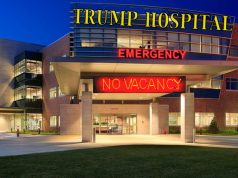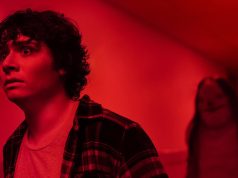(Reviewed in 2002, with revisions in 2017.)
“Halloween II” picks up exactly where “Halloween” left off, so closely that Part 1 might as well have ended with “To Be Continued.” It follows the aftermath of Michael Myers’ rampage on Halloween night 1978, with survivors being taken to the hospital, victims being mourned, Michael killing again, and so on.
It’s an interesting variation from what most other slasher films would do, which is to have the movie end with the “death” of the killer, and have the next one pick up a few years later, after everyone has moved on. Even “Friday the 13th” parts 2 and 3, which take place immediately after each other (and immediately after the first), show no sorrow on the part of the survivors over their fallen peers. They simply move ahead to the next murder venue, have some sex, and get killed.
Not that I’m going to accuse “Halloween II” of having a great deal of heart or compassion. It’s still a slasher flick, albeit a slightly more credible one than most of the films it inspired. It is still about a guy who kills people pretty much for no reason, though reasons are occasionally ascribed to him by screenwriters who feel they must earn the money they’re being paid.
This time, the obsessive and morose Dr. Loomis (Donald Pleasence) informs us that while in the mental hospital from which he escaped, Michael became acquainted with witchcraft and other things that make Halloween an extra-special day for him. We also are told, via a 5-second flashback and one direct statement, that Michael’s interest in killing Laurie Strode (Jamie Lee Curtis) is that she is his natural sister. Why he wants to kill his sisters is not explained, though those of us with sisters sort of understand.
And why did he kill all those other people, too? Just cuz, I guess. At the film’s beginning, the town learns of the murders Michael has just committed. The deaths are reported on the radio before most of the town’s cops have heard about them, which is either a tribute to the resourcefulness of the American media, or bad writing, one or the other.
Laurie, wounded in the first film, is taken to Haddenfield Memorial Hospital, where she is attended by a drunk doctor and hit on by a soft-looking teen-age ambulance driver. With the exception of a little boy who is in and out quickly, Laurie is the only patient in the entire hospital. (The nursery is full, though, so I don’t know where all those new mothers wandered off to.)
Michael makes his way to the hospital, stopping off at a random house just long enough to kill a random person and satisfy the audience’s bloodlust, as nearly 13 minutes have passed already and no one has been killed yet.
“Halloween” (1978) B
“Halloween II” (1981) C+
“Halloween III: Season of the Witch” (1982) F
“Halloween 4: The Return of Michael Myers” (1988) D
“Halloween 5” (1989) C-
“Halloween: The Curse of Michael Myers” (1995) C
“Halloween H20: 20 Years Later” (1998) D+
“Halloween: Resurrection” (2002) C-
“Halloween” (2007) D-
“Halloween II” (2009)
Meanwhile, Dr. Loomis is actively involved in screwing things up further. He and the cops chase an innocent kid who happens to be wearing a mask similar to Michael’s into traffic, where he becomes a bystander sandwich between two cars. Loomis expresses mild regret; the cops remain weak and malleable.
Back in the hospital, there’s a French-looking jackass who hits on a nurse, slips into a hot tub with her, then gets killed by Michael. There’s also a fat security guard who never looks at the surveillance cameras who meets his doom, and a few others here and there.
Laurie, doped up on medication, whimpers a lot in this movie. She also cowers in corners quite a bit. I’m always glad when movies have strong, dynamic protagonists.
Director Rick Rosenthal (working from John Carpenter and Debra Hill’s script) creates several long, quiet moments where tension is supposedly building. But since the outcome of each of these scenes is predictable — Michael will appear and kill the person — there is little point in dragging things out.
One thing the people who make these movies never seemed to learn is that if we don’t care about the characters, we’re not going to care if they die. There’s no suspense in wondering whether someone whose name we don’t even remember is going to be killed.
Anyway, there are some effectively subtle instances where Michael appears without a loud smash on the musical score. One especially memorable one has him in the background of a shot, through a window. It’s possible you wouldn’t even notice him, and it’s delightfully creepy if you do.
It seems a little cheap to have a sequel that merely completes the story you SHOULD have told in Part 1, as it makes the whole thing look like a two-part episode of a gory TV show. But as sequels go, this one’s not bad.
C+ (1 hr., 32 min.; )





